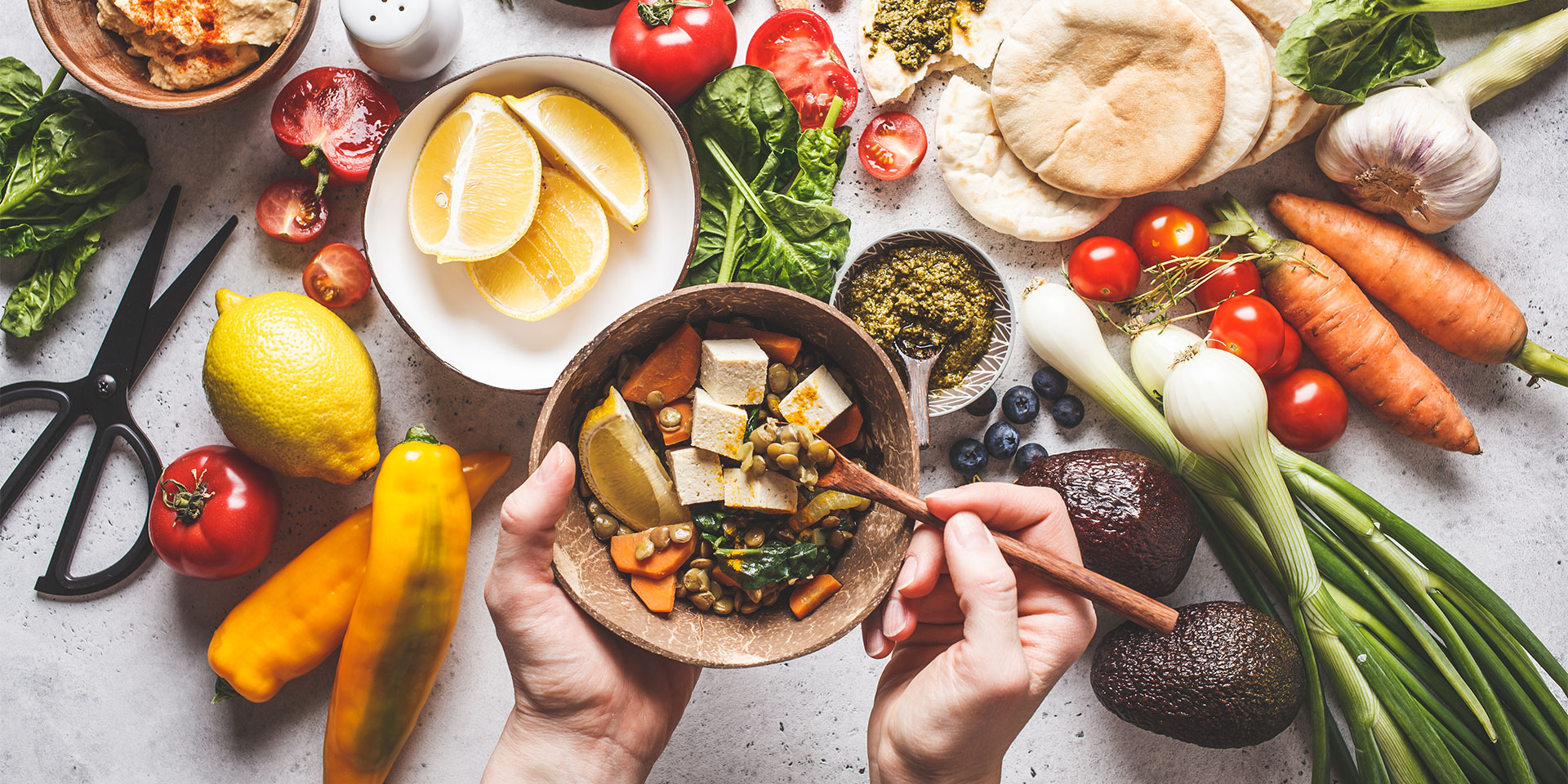Our attitude towards fruits and vegetables as well as other plant-based foods is almost paradoxical: they are probably the healthiest of foods, they are tasty (or can be prepared to be, with little skill), and they are relatively cheap. However, most people consume these super foods in smaller quantities than is necessary.
Data based on a survey conducted in 16 European countries (gathering over 33,400 subjects) showed that in only four European countries (Poland, Germany, Italy and Austria) the average consumption of fruits and vegetables is over 400 grams, which is the official recommendation supported by several organizations and institutions, including the World Health Organization.[1]
In the United States, a relatively recent survey indicated that only 2.2% of American men and 3.5% of women have a consumption that meets official daily recommendations for fruits and vegetables.[2]
In Australia, it has been estimated that about 50% of adults follow the recommendations on fruit consumption, and only 10% meet the recommended amount of vegetable intake.
Why do we eat too few fruits and vegetables?
The same is true for other starchy foods, such as sweet potatoes, dioscorea tubers, tapioca or cassava. Likewise, some food guides exclude dried legumes such as beans, peas or chickpeas from the vegetable group, combining them with meat in the group of high-protein foods, but other guides include them among “vegetables”.
Statistics show that, worldwide, about 402 plant species are grown as “vegetables” belonging to 69 taxonomic families and 230 genera. More than half of them (53%) are used for the leaves, about 15% for the fruits (in the botanical sense), and about 17% for the underground organs.
As for fruits, there is less controversy, but even in this case clarifications are needed on the inclusion of “nuts” and fruit juices. “Nuts” (the term includes walnuts, hazelnuts, peanuts, almonds, pistachios, etc.) are foods rich in energy, especially in the form of lipids. Some guides consider them fruits, others group them together with legumes. Olives and avocados also have an ambiguous position.
Regarding fruit juices, fresh ones can preserve many of the micronutrients from the fruit, but they lose fibre content and sometimes sugar is added to them. Many of the commercially available “juices” only vaguely reflect the content of the fruit from which they are claimed to come, so the consumption of such juices should not be considered as fruit consumption (the situation is similar in the case of jams that are very high in sugar).
What do we mean by “fruits and vegetables”?For example, from a purely botanical point of view, tomatoes and peppers are fruits (being formed by the development of the ovary of a flower); in terms of cuisine and official recommendations, however, they are “vegetables”. Also from a botanical point of view, vegetables rather point towards the species from the legume family (beans, peas, chickpeas, soybeans, etc.), and strictly scientifically, mushrooms are not even plants. But too few of us have botany in mind when it comes to sorting peppers, cucumbers, beans or mushrooms. Still, according to the official recommendations on the consumption of fruit and vegetables, for some plant-based foods, the classification is complicated and requires some clarification. Most of us tend to include potatoes or peas, for example, in the “vegetable” group. However, many food guides group potatoes together with cereals into the starchy food group.
|
Health benefits of fruits and vegetables
In 2002, in a report of the World Health Organization, low consumption of fruits and vegetables was classified as one of the 10 main risk factors that contribute to mortality with known causes. They also estimated that almost 1.7 million deaths worldwide (2.8% of all deaths) can be attributed to insufficient consumption of fruits and vegetables. Also worldwide, about 14% of deaths caused by gastrointestinal malignancies, about 11% of deaths caused by ischemic heart disease and about 9% of strokes originate in the same food deficit of fruits and vegetables.[3]
The benefits of fruits and vegetables for human health are multiple: reducing the risk of cancer, hypertension and cardiovascular disease, as well as the possible reduction of body weight and fat.
The role of vegetables and fruits in the diet in reducing the risk of cancer has long been known. Even though, in recent years, the association between fruit and vegetable consumption and reduced cancer risk has become weaker (possibly due to the considerable reduction in smoking), as mentioned by the American Oncology Society, “the totality of the evidence still supports some risk reduction associated with vegetable and fruit consumption for cancers of the lung, mouth, pharynx, larynx, oesophagus, stomach, and colorectum. For other cancers and for overall cancer incidence or mortality, evidence is either limited or inconsistent, although vegetables and fruits may indirectly influence cancer risk via effects on energy intake or body weight.”
Consumption of fruits and vegetables can help control blood pressure.
It is known that vegetarians have lower blood pressure values than people with an omnivorous diet. In clinical trials in which animal products were replaced by plant products, blood pressure was reduced for both normotensive and hypertensive patients. One of these studies which rigorously investigated the effects of fruit and vegetable consumption is known as DASH (Dietary Approaches to Stop Hypertension).
This study, which included 456 subjects, showed that a diet high in fruits, vegetables and low-fat dairy products and low in saturated and total fat reduced systolic blood pressure by 5.5 mmHg and diastolic blood pressure by 3, 0 mmHg, compared to a control diet.
The same study showed that even if the fats in the diet are not changed, but adequate amounts of fruits and vegetables are consumed, there is a decrease in blood pressure, although less pronounced than when fats are eliminated. An important observation was that the effect on blood pressure was established in two weeks and then maintained for another 6 weeks, during the study.
In general, the association between high fruit and vegetable consumption and cardiovascular health has been consistently maintained in the vast majority of studies to date. A systematic analysis based on 9 studies, involving over 90,000 men and 129,000 women, showed that for each additional portion of fruit or vegetables, the risk of cardiovascular events decreased by 4%, and for each additional portion of fruit, by 7%.
Fruits and vegetables have many health benefits
Another meta-analysis that brought together 12 studies, with a total of 278,459 subjects for over 11 years, showed that, compared to people who consumed less than 3 portions of fruits and vegetables per day, those who consumed between 3 and 5 portions had a reduced risk of cardiovascular disease by 7%, and those who consumed more than 5 portions had this risk reduced by 17%. Both these meta-analyses and other studies have shown that, in general, the protective effect of fruits and vegetables is dose-dependent: the higher the amount consumed, the greater the effect on cardiovascular risks.[4]
Obesity is the leading cause of disease in the West, one of the major factors causing many chronic diseases and high healthcare costs. Body weight control and weight gain prevention can be achieved to a large extent through the consumption of healthy foods, primarily fruits and vegetables, but also whole grains.[5]
Several studies have shown that people who eat more vegetables and fruits gain less weight and are less exposed to the risk of obesity.
Of course, these foods also contain calories, but they are rich in fibre and water, poorer in energy, are slower to digest, so they can increase satiety and reduce overall energy intake.[6] A systematic analysis of 12 experimental studies concluded that there was a slight association between increased fruit and vegetable consumption and weight loss in adults (but not in children).[7]
The analysis of 11 other studies, with longitudinal design, showed that an increased consumption of fruits and vegetables is associated with a lower weight gain or a slower weight gain over time, compared to a lower consumption of fruits and vegetables; this time as well, the effects were more pronounced in adults than in children. For example, a study in Spain, which looked at 206 healthy subjects for 10 years, found that those with the highest consumption of fruits and vegetables had the lowest risk of gaining weight[8].
Increased consumption of fruits and vegetables is associated with lower weight gain.
Another study looked at more than 74,000 women for 12 years. During this period, the trend was to gain weight, but women with the highest consumption of fruits and vegetables had a 24% lower risk of becoming obese than those with the lowest consumption of these foods (calculations took into account and adjusted the results for age, physical activity, smoking, etc., so that the 24 percent reflects the contribution of vegetables and fruits). Obviously, how these foods are prepared also matters. If fruits and vegetables are eaten fried or with sauces and other high-calorie foods (cheese sauces, mayonnaise, etc.) or if sugary juices are seen as “fruit”, the likelihood of controlling body weight is reduced.
Even if there is less evidence, it would seem that fruits and vegetables also play a role in preventing rheumatoid arthritis.
An epidemiological study showed that participants with the lowest consumption of fruits and vegetables had a higher risk of developing inflammatory polyarthritis, compared to participants with the highest consumption of fruits and vegetables. Other studies have also shown that fruit and vegetables have an effect on the risk of rheumatoid arthritis, although in some cases the effect was relatively small and in one case the effect was observed only for cooked vegetables, not for those eaten raw.
Other research also indicates potential benefits for other diseases that fruit and vegetable consumption could prevent or reduce, such as depression, chronic kidney disease, osteoporosis or dementia, and cognitive decline due to age. In any case, increasing the consumption of fruits and vegetables can only have benefits for our health.
Increasing the consumption of fruits and vegetables can only have benefits for our health.
A UK study estimated, in a conservative scenario, that adding an extra serving of vegetables or fruit a day can prevent about 2,700 cardiovascular deaths a year, and the number should be increased by another 20% if we also include the prevention of cancer deaths. An increase of three servings per day would reduce the number of cardiovascular deaths by about 7,420. To these should be added other potential benefits that have not been quantified.
Even so, in the UK and the rest of the world, fruit and vegetable consumption remains well below the recommended level of at least 400 grams per day (and some countries currently recommend a minimum of 600 grams per day).
What can be done about it?
Authorities in many countries have experimented and continue to test various interventions and policies designed to stimulate the consumption of fruits and vegetables in the general population or subpopulations (children, the elderly, disadvantaged populations, etc.). Some of these interventions aim to influence demand and others to influence supply. In terms of demand, research has shown that people on low incomes are more likely to consume much less plant foods than people on higher incomes.
There is convincing evidence that a 10% reduction in the price of fruit and vegetables stimulates their purchase by about 7% and 5.8%, respectively.
Therefore, some government programs have proposed the granting of vouchers specifically for the purchase of fruits and vegetables in certain stores. When implemented, such programs have stimulated the consumption of these foods. Other demand-side interventions are aimed at informing consumers by displaying nutritional content on menus or packaging, or educating the public about the benefits of eating fruits and vegetables. Such interventions have had variable results.
On the supply side, most programs aimed to increase consumption of fruit and vegetables by making them available in schools, universities, hospitals, public institutions, orphanages etc. Starting with the 2009-2010 school year in the European Union the program entitled “Fruits in Schools” provides co-financing of fruit and vegetable distribution in schools.
A report by the European Court of Auditors shows that, compared to the parallel program to encourage milk consumption, the fruit and vegetable program is more likely to achieve its objectives. This program, like similar ones, covers only a part of the national population, and the effectiveness is not 100%. Therefore, ensuring a healthy diet from this point of view is still the responsibility of each of us.
Robert Ancuceanu, PhD, is a professor in the Faculty of Pharmacy at the Carol Davila University of Medicine and Pharmacy in Bucharest, Romania.













 The same is true for other starchy foods, such as sweet potatoes, dioscorea tubers, tapioca or cassava. Likewise,
The same is true for other starchy foods, such as sweet potatoes, dioscorea tubers, tapioca or cassava. Likewise, 




